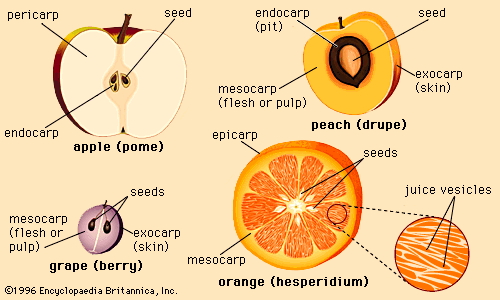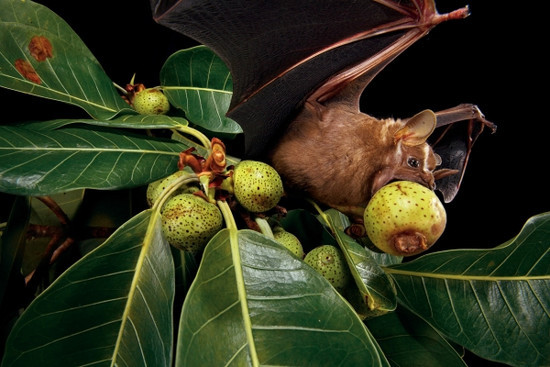WHAT IS A
FRUIT?
We consume
fruit every day, it's one of our supply bases, we are highly recommended to eat
five pieces per day.
But in fact,
what is it a fruit?
What is it
for?
To
understand what a fruit is and what is the justification for its existence, you
have to be placed in the perspective of the plant, not of the human being who
wants to eat a dessert, or who wants to eat balanced.
The plant,
like all living beings, has a top priority in life, to reproduce, to ensure the
sustainability of the species. In most cases, it makes it through the
production of seeds.
Picture: http://www.sawondo-sport.com/images/206/blog/206_5833.jpg
The usual
meaning of the word includes most sweet plant products, which are often eaten
as dessert. We find there apple, peach, cherry, mango, lychee, custard apple
and many others. It also includes pineapple, pear and strawberry for example,
which are not fruits (these are false fruits, infrutescences in the case of
pineapple or fig, polyachene in the case of strawberry) or hazelnuts, almonds,
walnuts, under the generic name of "dry fruits" which are not either.
However we don't include eggplant, pepper, pumpkin or zucchini that are yet.
I
will focus today in the botanical sense of the word, so the role of the fruit
from the viewpoint of the plant. The plant world does nothing by chance. If the
fruit exists, there is a justification for its existence. Man consumes the
fruit because he found it by chance during his research, at the time when he
was still a hunter-gatherer, and he has since learned to domesticate it through
agriculture.
The fruit is
the shell of the seed, whose shape, size, color and consistency vary. The fruit
only exists for the seed. A simple proof: if pollination is poor, and the seed
aborts, the little fruit drops before starting its development. The plant can't
spend all the energy required to manufacture a fruit, if the seed can't be
formed, at the risk of running out unnecessarily.
The general
structure is the same regardless of the fruit. These are the differences in
appearance, texture, composition and proportion of each of these elements that
determine the characteristics of each fruit.
Here is what
Wikipedia says in its French edition:
Picture: https://66.media.tumblr.com/tumblr_lllbhvyLO61qktyf1o1_500.gif
"Pericarp
The pericarp is the wall of the
fruit, coming from the processing, after the fecundation, of the wall of the
ovary. For false fruit, it's the result of the transformation of the floral
receptacle.
The pericarp is composed of three
layers:
- The epicarp, often colored,
usually called skin;
- The mesocarp, which gives the
juicy part of fleshy fruits.
- The endocarp, sometimes lignified
and called core."
But the
plant is facing a fundamental problem: it can't move.
Yet
it needs that its seeds are transported a bit or much further, something it
can't do alone, except in special cases (as is the case of the squirting
cucumber, ecballium elaterium, able to project its seeds to more than ten
meters away https://www.youtube.com/watch?v=wOIHzl2h9a8
).
Why this
need to send the seeds further?
To avoid
overcrowding in the same restricted zone and a food and survival problem. It
therefore needs to disperse its seeds around, outside the influence of the
mother plant canopy area. The plant kingdom has shown an amazing ability to
imagine and implement varied and efficient systems to get there.
Some plants
use animals for transporting seeds. For this, the seed must be attractive, but
protected.
Others
prefer to use air or water as a means of transport. The seed must be light and
"equipped" to travel.
So back to
our plant, bearing fruit, often big and heavy, trying to disperse its seeds
several meters off the mother plant.
What is the
solution? To use animals, that can move, which will pass in the surroundings.
But for this it has to attract them. So we'll find a wide variety of colors,
shapes, aromas, flavors, and even fruit size, to attract certain types of
animals in particular.
For example,
all fruit whose seed is large (peach, apricot, mango, plum, etc.), are seeking
to attract mammals or large reptiles, which will be able to carry them.
Fruits with
small seed (apple, pear, citrus, tomatoes, cucurbits and other) may also
attract birds and small rodents.
But the
fruit itself, the one we eat, carefully avoiding the core, what does it really
do?
It plays
several roles, often successive, during its development.
Throughout
the cycle, it has a permanent protective role for the seed itself. For example,
in case of frost or hail, the envelope will be damaged first. The seed only
will be affected in the event of serious problem.
At the
beginning of the cycle, the seed in formation, still very small, is enveloped
by the flesh, that protects from climate problems, and is usually unattractive,
repulsive or even toxic to animals and insects, to prevent the fruit is eaten
before the seed is viable.
During this
phase, if the plant is in a perilous situation in which its survival is
threatened, it still has the possibility to offload (partially or totally) its
fruits to try to survive. It "knows" that, as it is still on the
beginning of the cycle, it has no chance to drive the seed to maturity. It is
more prudent to offload to try to survive the problem, to be able to retry the
following year.
Then
occurs the fruit set, a complex hormonal phenomenon that makes the fruit hangs
permanently in the plant. There is practically no more possible physiological
fall. The fruit grows, at the same time that the seed develops and grows. It
can be used by the plant as a reserve of water and nutrients, in case it would
be in a situation of risk (drought, flooding, pest attack), which would
jeopardize its survival. This tank that the fruit is, allows the seed to
complete its evolution, even if the plant eventually dies. In plants, as in
wildlife, the priority is not the survival of the individual, but the
perpetuation of the species. It is normal and usual that an individual is
sacrificed for the survival of the group or the progeny.
Once the
evolution of the seed is complete, the plant will cause fruit ripening,
accompanied by a change of its color and the production of attractive
substances such as sugars and flavorings in order to attract the animals that
the plant needs for seed dispersal. The animals will locate, then consume or
take the fruit and reject the seed a little further, thus contributing to the
dissemination of plant species.
Size, color,
type of meat, flavors are so many characters that will determine which animals
will be attracted to each type of fruit. The local evolution of wild
individuals will also add genetic variability within the same plant species.
Plant
breeders, those who create varieties by natural means (by controlled
pollination, not by transgenesis), look for this genetic variability due to
random crossings in nature, and local adaptation, in order to transmit
interesting characters. For example, a wild fruit native to a very damp area
will probably develop a tolerance or resistance to certain fungal or bacterial
diseases favored by moisture. This character may be transmitted to its progeny.
Picture: http://leschauvessouris.l.e.pic.centerblog.net/ef0529ca.jpg
For the
farmer, in the case of most fruits and vegetables, what matters most is the
envelope, not the seed, which often is not consumed. But, except for special
cases, no seed, no fruit.
This is why
it is important to understand that the objective of agriculture is to produce
the fruit, while the plant aims to produce the seed contained in the fruit.
Our interest
in the fruit is not the same as the plant's one.
The plant
protects its seed through the fruit. The fruit is there to undergo all kinds of
aggressions, weather, insect or disease. It is irrelevant as long as the seed
is safe.
But the
farmer has to protect the plant against all external aggression, because his
goal is to get a presentable, beautiful fruit, to be able to sell it.
It must
protect the protector.
He must be
able to produce the fruit, even if the seed is not viable.




Aucun commentaire:
Enregistrer un commentaire